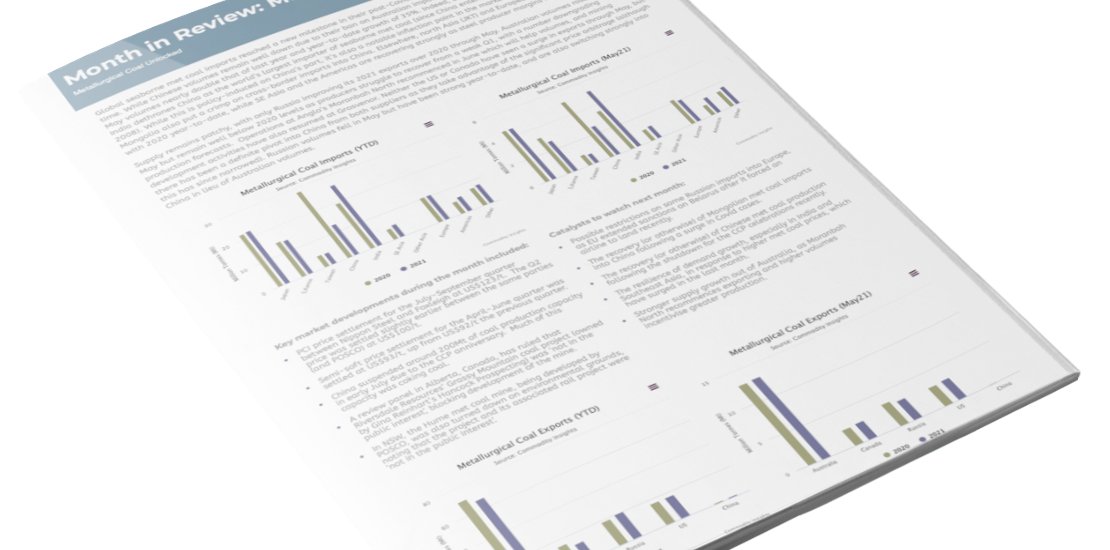
A new way of looking at metallurgical coal data and insights
Commodity Insights is excited to announce the official release of our Metallurgical Coal Unlocked portal, which provides a comprehensive one-stop-shop for industry participants incorporating the latest sector data and insights.
Designed by industry experts, we’ve combined 20 years of correctly classified and reconciled trade data with our independent price forecast, the latest steel spreads and a monthly executive level report. Users can explore the latest metallurgical coal data using intuitive charts, and customise the outputs into their reports and analysis functions.
To celebrate the release, we are pleased to attach a complimentary copy of this month’s Market Report, incorporating full global data for May, which was sent to subscribers last week.
Subscribe today to discover new insights
Met Coal Market Report: July 2021 Metallurgical Coal Unlocked
Global seaborne met coal imports reached a new milestone in their post-Covid recovery in May, passing 2020 levels for the first time. While Chinese volumes remain well down due to their ban on Australian imports, Indian demand continues to surge, with May volumes nearly double that of last year and year-to-date growth of 35%. Indeed, 2021 could represent the year when India dethrones China as the world’s largest importer of seaborne met coal (since China entered the import market materially in 2008). While this is policy-induced on China’s part, it’s also a notable inflection point in the market. High levels of Covid cases in Mongolia also put a crimp on cross-border imports into China. Elsewhere, north Asia (JKT) and European volumes are steady with 2020 year-to-date, while SE Asia and the Americas are recovering strongly as steel producer margins remain high.
Supply remains patchy, with only Russia improving its 2021 exports over 2020 through May. Australian volumes rose slightly in May but remain well below 2020 levels as producers struggle to recover from a weak Q1, with a number downgrading production forecasts. Operations at Anglo’s Moranbah North recommenced in June which will help volumes, and mining development activities have also resumed at Grosvenor. Neither the US or Canada have seen a surge in exports through May, but there has been a definite pivot into China from both suppliers as they take advantage of the significant price arbitrage (although this has since narrowed). Russian volumes fell in May but have been strong year-to-date, and are also switching strongly into China in lieu of Australian volumes.
Key market developments during the month included:
- PCI price settlement for the July-September quarter between Nippon Steel and Foxleigh at US$123/t. The Q2 price was settled slightly earlier between the same parties (and POSCO) at US$100/t.
- Semi-soft price settlement for the April-June quarter was settled at US$93/t, up from US$92/t the previous quarter.
- China suspended around 200Mt of coal production capacity in early July due to the CCP anniversary. Much of this capacity was coking coal.
- A review panel in Alberta, Canada, has ruled that Riversdale Resources’ Grassy Mountain coal project (owned by Gina Reinhart’s Hancock Prospecting) was ‘not in the public interest’, blocking development of the mine.
- In NSW, the Hume met coal mine, being developed by POSCO, was also turned down on environmental grounds, noting that the project and its associated rail project were ‘not in the public interest’.
Catalysts to watch next month:
- Possible restrictions on some Russian imports into Europe, as EU extended sanctions on Belarus after it forced an airline to land recently.
- The recovery (or otherwise) of Mongolian met coal imports into China following a surge in Covid cases.
- The recovery (or otherwise) of Chinese met coal production following the shutdown for the CCP celebrations recently.
- The resilience of demand growth, especially in India and Southeast Asia, in response to higher met coal prices, which have surged in the last month.
- Stronger supply growth out of Australia, as Moranbah North recommences exporting and higher volumes incentivise greater production.
